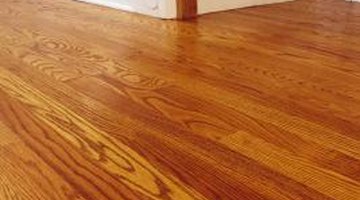How to Cut Returns in Stair Treads
A staircase does more than help you get safely from one floor of your home to another. The details of your staircase enhance your home and show its quality. Returns on stair treads are one such detail. Returns are finished edges that "return" to meet the wall, showing no raw wood. For example, an open banister on an uncarpeted wooden stairway exposes the edges of the stair treads. Therefore, a space must be cut into the treads to allow for trim with an edge that matches the rounded "bullnose" shape of the tread.

Step 1
Measure the width of your bullnose stair trim. This trim is usually 1 1/4 inches wide.
Step 2
Line up your combination square for a 45-degree miter cut on the front corner of the side of the tread that will be exposed. The return may be on the right edge of the tread, the left edge or both -- called a double return -- if the stairway is open on both sides. Mark the corner for a 45-degree cut that's as long as the bullnose stair trim is wide.
Step 3
Unplug your table saw. Install a fresh blade intended for cross cutting wood, according to the manufacturer's guidelines. Plug the saw back in. Put on safety glasses.
Step 4
Make the 45-degree, 1 1/4-inch cut with the table saw. Remove the tread. There should be a 1 1/4-inch diagonal slice in the appropriate front corner of the tread.
Step 5
Mark 1 1/4 inches from the edge of the tread along the same side, using the ruler on the combination square as a guide.
Step 6
Run the tread through the tablesaw at the 1 1/4-inch mark, from the end opposite the miter cut until you reach the bottom of the mitered cut. Do not cut too far to avoid cutting into the miter.
Step 7
Finish the cut with a handsaw to remove any excess between the cross cut and the mitered cut.
Step 8
Mark and cut the bullnose stair trim with a 45-degree miter cut that lines up with the cut in the tread. The back end of the trim should extend just beyond the face of the stair riser that butts up against the tread. The back end of the trim, opposite the miter cut, can be routed with a bullnose router bit to give it a finished edge.
References
Tips
- Stair treads can be purchased with spaces for returns precut.
- An alternative is to cut the treads flush to the stringers and apply bullnose stair trim across the front of the step and the exposed side, mitering it at the corner, as with any other type of trim.
- Carpentry shops that do a lot of stairs may want to invest in specialized equipment that automatically cuts stair treads for returns.
- The stair trim is applied with wood glue and finishing nails.
Warnings
- Follow all manufacturer recommended safety guidelines when operating power tools.
Writer Bio
Patricia Hamilton Reed has written professionally since 1987. Reed was editor of the "Grand Ledge Independent" weekly newspaper and a Capitol Hill reporter for the national newsletter "Corporate & Foundation Grants Alert." She has a Bachelor of Arts in journalism from Michigan State University, is an avid gardener and volunteers at her local botanical garden.
Photo Credits
- Comstock/Comstock/Getty Images
More Articles



